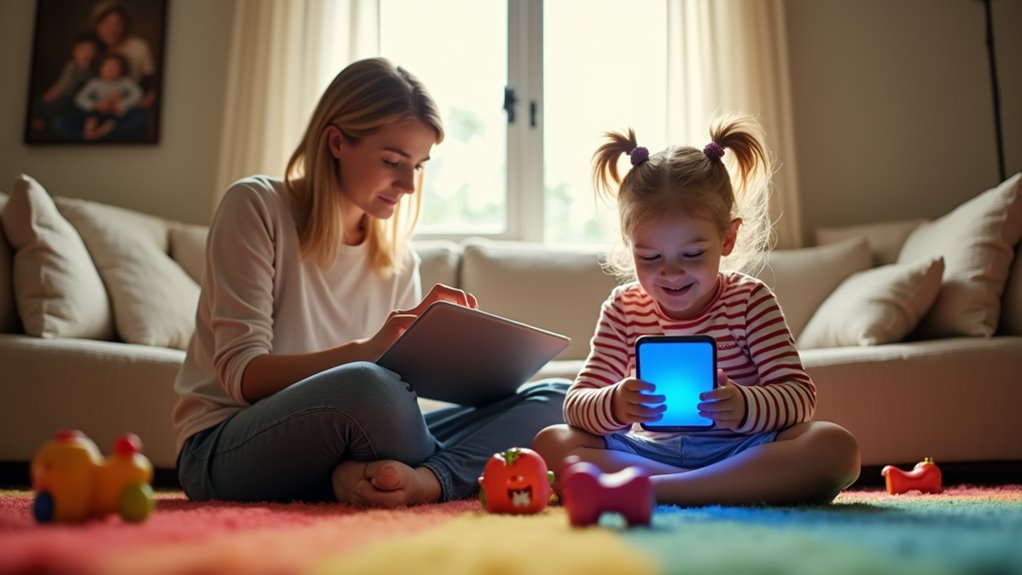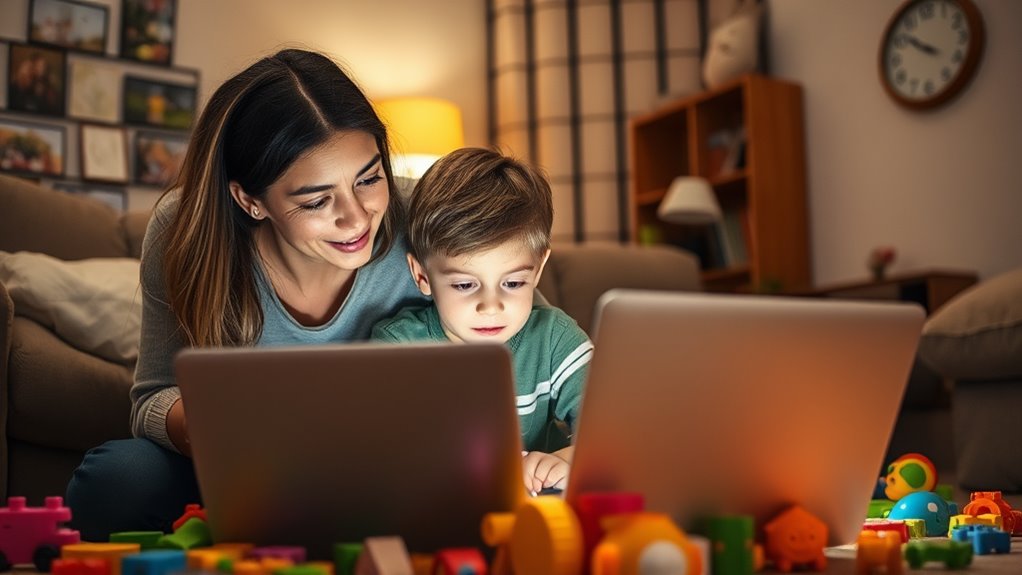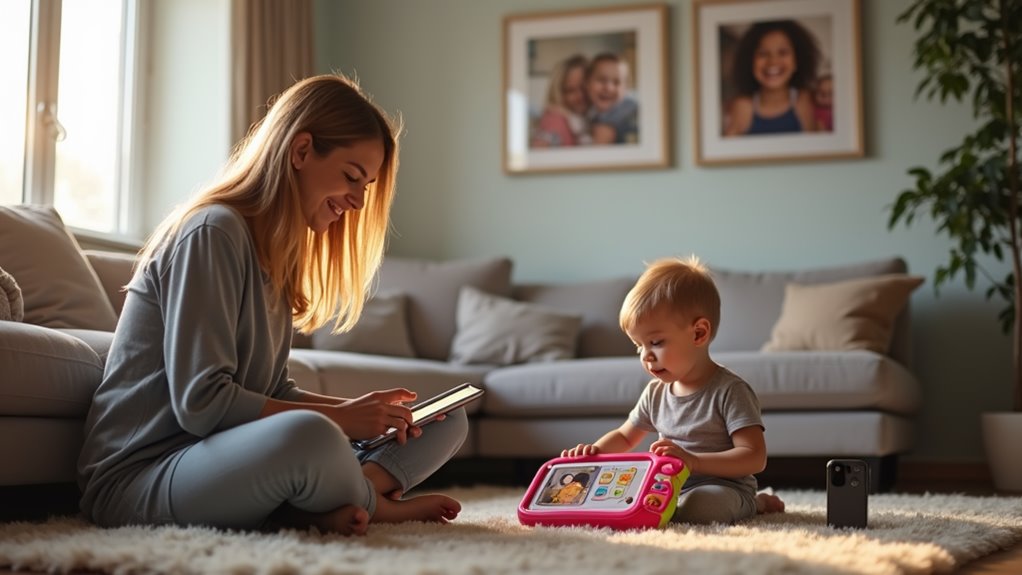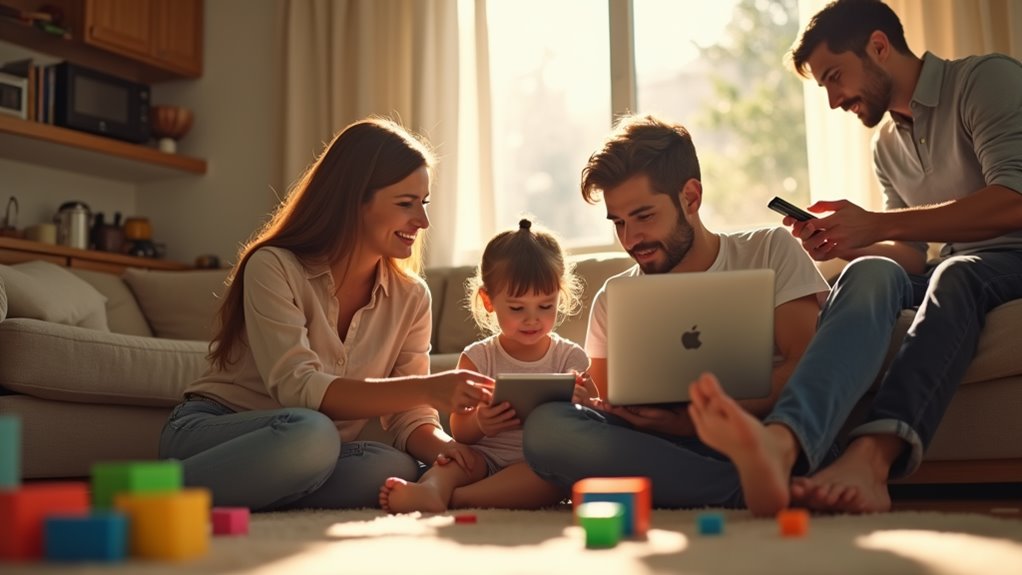Technology’s really changed how you talk with your kids, hasn’t it? While instant messaging and video calls keep everyone connected, they can also lead to misunderstandings and feel like a distraction. You might notice family dinners turning into screen time marathons instead of chat fests. But don’t worry! Setting aside device-free time can help you bring back those meaningful conversations. Plus, social media lets you peek into your child’s world, strengthening your bond with shared moments. It’s a balancing act, but focusing on quality time makes all the difference. Stick around, and you’ll discover even more tips to enhance your communication!
Evolution of Communication Methods
Communication methods have evolved dramatically over the years, shaping how parents and children interact. Think about it: back in the day, a parent might’ve sent a letter to a child at camp, waiting days for a reply. Now, you can shoot a quick text or FaceTime anytime! This shift makes it easier to stay connected, but it also means you’ve got to navigate a whole new world of tech.
With the rise of smartphones and social media, conversations have become quicker but sometimes less personal. You might find yourself texting instead of talking face-to-face. While that’s super convenient, it can also lead to misunderstandings. Emojis can’t replace a warm hug, right?
Remember the days of family dinners where everyone shared stories? Nowadays, it’s common to see everyone glued to their screens instead of chatting. It’s like a scene from a sci-fi movie!
But don’t worry, you can still create meaningful moments. Setting aside device-free time can help bring back those heart-to-heart conversations. So, embrace the tech, but don’t forget those good old-fashioned chats! Balance is key in this digital age.
Benefits of Digital Communication
While some may argue that digital communication lacks depth, it actually offers numerous benefits that can enhance parent-child relationships. For starters, texting or using apps lets you stay connected throughout the day. Imagine sending a quick “I love you” or “How’s your day?” during a busy afternoon. It’s like giving a little digital hug!
Another great perk is the ability to share experiences instantly. You can send photos or videos of your day, whether it’s a funny moment at school or a delicious meal you made. These small bits of sharing can spark conversations and help you bond over shared moments, even when you’re apart.
Plus, digital communication can help shy kids express themselves better. Sometimes, it’s easier to share feelings through a screen than face-to-face. You might get insights into their world that you wouldn’t have known otherwise.
Lastly, technology can keep you informed about each other’s interests. Whether it’s a new hobby or a favorite show, you can chat about it anytime.
Challenges of Virtual Interaction
Often, virtual interaction can create misunderstandings between parents and children. You might text your child about dinner plans, but they misread your tone and think you’re angry. Yikes! Suddenly, a simple message turns into a mini-drama.
It’s easy for tone and feelings to get lost in translation when you’re not face-to-face.
Another challenge is distractions. Whether it’s a buzzing phone or a video game calling their name, kids can easily get sidetracked during a conversation. You could be sharing your day, but they might be more focused on their latest TikTok trend.
This can leave you feeling ignored or frustrated.
Then there’s the issue of overthinking. When you send a message, you might wonder if they’ll think you’re being too strict or too casual. You second-guess yourself, and they might feel the same way.
Lastly, let’s not forget the dreaded “read” receipt. If they read your message but don’t reply, panic might set in. Did you say something wrong?
Impact of Social Media
Social media can greatly shape the way parents and children connect with each other. It’s like a digital playground where you can share thoughts, photos, and funny memes. For parents, platforms like Facebook or Instagram let them peek into their kids’ lives, seeing what they’re up to without being too nosy. You might think it’s cool when your parents like your posts, or maybe it’s a little embarrassing. Either way, it’s a way to bond!
On the flip side, social media can sometimes spark misunderstandings. You might post something funny, but your parents could misinterpret it. Maybe they think you’re being serious when you’re just joking around. This miscommunication can lead to awkward conversations.
But here’s the fun part: social media can also help you share interests. If you both love the same show, you can discuss episodes or share fan art. It’s like having a secret club!
Role of Messaging Apps
Messaging apps have transformed the way parents and children communicate daily. You can text your child a quick “How’s your day?” while they’re at school, and just like that, you’re connected! These apps let you send messages anytime, anywhere, which is super helpful when you want to check in without interrupting their busy lives.
Not only can you share quick updates, but you can also send funny memes or pictures to lighten their mood. Imagine your child’s face lighting up when they receive a silly cat video from you!
Plus, messaging apps often allow you to create group chats. This means the whole family can stay in the loop about plans or activities.
However, it’s important to remember that while texting is convenient, it can’t fully replace face-to-face conversations. Sometimes, your child might need to hear your voice or see your smile to feel truly connected.
Still, these apps have opened up new ways to communicate, making it easier to share love and support. So, embrace the power of messaging apps, and enjoy the little moments of connection they bring into your daily life!
Balancing Screen Time
Finding the right balance between screen time and quality interactions can be challenging for parents today. You might find yourself wondering how much is too much when it comes to devices. It’s easy to get wrapped up in screens, whether it’s scrolling through social media or binge-watching a show.
However, you want to make sure you’re spending time with your kids, too!
One strategy is to set specific times for family activities that don’t involve screens. Think about game nights or outdoor adventures. You’ll create lasting memories while giving everyone a break from tech. Plus, it’s a great way to reconnect and share laughs, which can sometimes feel like a rare treat!
Another tip is to lead by example. If you limit your own screen time, your kids are likely to follow suit. You might even make it a fun challenge—who can go the longest without checking their phone?
Just remember, finding balance isn’t about eliminating screens completely; it’s about ensuring that technology doesn’t overshadow those precious moments together. So, keep it light, stay engaged, and you’ll strike that perfect balance!
Technology and Emotional Connection
While technology can sometimes create barriers in parent-child relationships, it also offers unique opportunities to strengthen emotional connections.
Think about it—texting your child can be a quick way to check in during their busy day. A simple “How’s it going?” can make them feel loved and remembered, even if you’re miles apart.
Video calls are another great tool. When you can’t be together in person, seeing each other’s faces can brighten your day. You can share a laugh or even read a bedtime story together, making the distance feel a little smaller.
Plus, sharing memes or funny videos can create inside jokes that help you bond.
Using social media can also let you peek into each other’s lives. You can comment on their posts or share memories, reminding them that you’re there, cheering them on.
But remember, it’s not just about the screens; it’s about how you use them! Technology can help you connect on a deeper level, showing support and love in ways that words alone sometimes can’t.
Setting Communication Boundaries
Embracing technology can enhance emotional connections, but it’s equally important to establish communication boundaries. Setting these boundaries helps create a healthy balance between tech use and real-life interactions.
You might want to reflect on having specific times when devices are put away, like during family dinners or before bedtime. This way, you can focus on each other without the constant buzz of notifications interrupting your conversations.
It’s also a good idea to discuss what topics are off-limits during tech time. For instance, maybe you want to steer clear of school stress or chores when you’re chatting online. This helps keep the vibe light and fun!
And hey, don’t forget to model these boundaries yourself. If you expect your child to unplug, you should do the same.
Future of Parent-Child Communication
How will advancements in technology reshape the way you communicate with your child in the coming years? Imagine a world where you and your child can chat through virtual reality! You could sit together in a digital park, even if you’re miles apart. This could make conversations feel more personal and fun.
With the rise of smart devices and apps, you’ll have tools that help you connect like never before. Picture sending a quick voice message while you’re busy cooking dinner, so your child knows you’re thinking of them.
Or, using family group chats to share silly memes that spark laughter and build bonds.
As technology grows, you might also see devices that can help your child express feelings better. Maybe a robot that encourages them to share what’s on their mind, making it easier for you both to understand each other.
Of course, while you’re enjoying these advances, it’s important to remember to unplug sometimes. After all, nothing beats a good old-fashioned heart-to-heart!
Balancing tech and face time will be the key to a bright future in parent-child communication.





